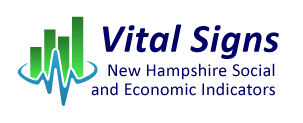How Old Are You? About Population and Age (Print Version ![]() )
)
People make the place, and demographics are the characteristics of people in a place. The US Census Bureau compiles a variety of demographic data on people in the US, such as age, race, ethnicity, ancestry, language spoken at home, place of birth, and more.
In New Hampshire, the age of the state’s population is a frequent topic of discussion. Businesses, policy makers, planners, and elected officials must address a variety of issues hinging on the current and projected age of the population, such as:
- Available labor force and employee recruitment
- Education funding, public school building needs, and higher education facilities
- Child care and elder care services
- Housing units designed for specific age groups, such as workforce housing, 55-plus housing, or multiple-bedroom units for families
- Medical care and emergency services
How Old is New Hampshire’s Population?
In 2011, just over half of the state’s residents were in their “prime earning years,” between 25 and 64 years of age. Those aged 45 to 64 years hold the largest share of the population, 30 percent, and those aged 25 to 44 years represent 23 percent of the population. Residents of retirement age, 65 and over, represent 18 percent of the population.

Why is Age Significant?
In 2000, the largest share of the population was in two age groups: 35 - 39 and
40 - 44 years. In 2010, that portion of the population still held the largest share, but are 45 - 49 and
50 - 54 years old. Population projections estimate that by 2020, the largest share of the population will be consolidated in the 60 - 64 years group. By 2030, the largest share will be 65 - 69 years old. These estimates are an indication of potential challenges for health care, housing, and other services to meet the needs of a growing number of elderly residents.
In addition to increased numbers of residents in the older age groups, a projected lack of increase in younger age groups creates different challenges. The number of people age 65 and over is expected to be nearly three times larger in 2030 than in 2000, while the number entering working age — those in the 15 - 19 and 20 - 24 years age groups — is projected to be about the same. As older residents leave the labor force, not only will more services be needed for their care, but younger people will also be needed to replace them in the labor force.
Though currently there seems to be a shortage of jobs, there may not be enough people to fill those same jobs twenty or more years into the future. If all else remains the same, New Hampshire is facing a potential labor shortage. In-migration of new residents, both domestic (from other states) and international (from other countries), will be an important factor in population increase for New Hampshire to meet the future demand for workers.
Katrina Evans

![]() Adobe Acrobat Reader format. You can download a free reader from Adobe.
Adobe Acrobat Reader format. You can download a free reader from Adobe.
Translation Resources and Disclaimer
New Hampshire Employment Security (NHES)
45 South Fruit Street | Concord NH 03301 | 603-224-3311 | 1-800-852-3400
TDD Access: Relay NH 1-800-735-2964





